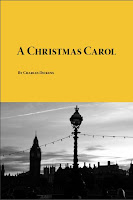Sources
The principal forces that shaped A Christmas Carol were the profoundly humiliating experiences of the author's childhood, his sympathy during the decades of the 1830s and 1840s with the poor, especially children, and Washington Irving's stories of the traditional old English Christmas. While there are other authors before Dickens who celebrated the season, it was Dickens who imposed his secular vision of the holiday upon the public.
In 1824, Dickens's father John Dickens was arrested for debt and imprisoned in the Marshalsea. The family moved into the prison but twelve-year-old Charles was forced to take lodgings nearby, pawn his collection of books, leave school, and accept employment in a blacking factory. The boy had a deep sense of class and intellectual superiority and was entirely uncomfortable in the presence of the other factory workers who referred to him as "the young gentleman". He developed nervous fits. When his father was released at the end of a three month stint, young Dickens was forced to continue working in the factory which only grieved and humiliated him further. He despaired of ever recovering his former happy life. The devastating impact of the period wounded him psychologically, coloured his work, and haunted his entire life with disturbing memories. It was during this period Dickens observed the lives of the men, women, and children in the most impoverished areas of London and witnessed the social injustices they suffered.
In early 1843, Dickens toured the Cornish tin mines where he saw children working in the most appalling conditions. The suffering he witnessed there was reinforced by a visit to the Field Lane Ragged School, one of several London schools set up for the education of the capital's half-starved, illiterate street children. Dickens read the Second Report of the Children's Employment Commission dated February 1843, a parliamentary report that exposed the horrifying effects the Industrial Revolution inflicted upon the lives of poor children. In a speech at the Manchester Athenaeum, he urged workers and employers to join together to combat ignorance with education. In May 1843, he planned to publish an inexpensive political pamphlet tentatively titled, "An Appeal to the People of England, on behalf of the Poor Man's Child" but changed his mind, deferring the pamphlet's production until the end of the year. He wrote Dr. Southwood Smith, one of four commissioners responsible for the Second Report, about his change in plans: "[Y]ou will certainly feel that a Sledge hammer has come down with twenty times the force – twenty thousand times the force – I could exert by following out my first idea." The pamphlet would become A Christmas Carol.
The descriptions of long-abandoned English Christmas customs and traditions in Washington Irving's Bracebridge Hall attracted Dickens,[2] and the two authors shared the belief that the staging of a nostalgic English Christmas might restore a social harmony and well-being lost in the modern world. In "A Christmas Dinner" from Sketches by Boz (1833), Dickens had approached the holiday in a manner similar to Irving, and, in the Pickwick Papers (1837), he offered an idealized vision of an 18th century Christmas at Dingley Dell. In the Pickwick episode, Mr. Wardle relates the tale of Gabriel Grub, a lonely and mean-spirited sexton, who undergoes a Christmas conversion and transformation after being visited by goblins who show him the past and future – the prototype of A Christmas Carol.
Other likely influences were a visit made by Dickens to the Western Pentitentiary in Pittsburgh, Pennsylvania in April 1842;[11][note 1] the decade-long fascination on both sides of the Atlantic with spiritualism;[3] fairy tales and nursery stories (which Dickens regarded as stories of conversion and transformation);[12] contemporary religious tracts about conversion;[12] and the works of Douglas Jerrold in general, but especially "The Beauties of the Police" (1843), a satirical and melodramatic essay about a father and his child forcibly separated in a workhouse,[11] and another satirical essay by Jerrold which may have had a direct influence on Dickens's conception of Scrooge called "How Mr. Chokepear keeps a merry Christmas" (Punch, 1841).[1]
The Chancery Lane offices, formerly Smithson's solicitors in the town of Malton, North Yorkshire were the model for Scrooge’s counting house in Carol, and that the church bells which feature so prominently in the novel were those of St. Leonard’s on Church Hill, Malton. Dickens befriended Smithson whilst he was in London completing his legal training. A lifelong friendship ensued which involved Dickens visiting Malton many times and featuring many of the people and places he met through Smithson in his writings.

Charles Dickens
A Christmas Carol (originally, A Christmas Carol in Prose, Being a Ghost Story of Christmas) is a novella by English author Charles Dickens about a miserly curmudgeon and his secular conversion and redemption after being visited by four ghosts on Christmas Eve. The book was first published on 19 December 1843 with illustrations by John Leech, and quickly met with commercial success and critical acclaim. The tale has been viewed as an indictment of nineteenth century industrial capitalism and has been credited with returning the holiday to one of merriment and festivity in Britain and America after a period of sobriety and sombreness. A Christmas Carol remains popular, has never been out of print,[1] and has been adapted to film, opera, and other media.
Book Categories
- Agricultural
- Art
- Autobiography
- Automotive
- Biography
- Business
- Calculus
- Children's
- Comic
- Computer
- Cooking
- Culture
- Dictionary
- Economic
- Education
- Electronic
- Essay
- Exterior-Interior
- Fashion
- Free Ebook
- Games
- Garden
- Gender-HAM
- Health-Medical
- Humor
- Journalism
- Language
- Law
- Magic
- Managemen
- Marketing
- Memoir
- Military
- Multimedia
- Music-Movie
- Mystery
- Nature
- Novel
- Parenting
- Philosophy
- Poetry
- Politics
- Publishing
- Religion
- Science
- Short Story
- Sport
- Traveling
- Youth
- Z] The End
A Christmas Carol
Label: A] AGAMA, Art, N] Sastra-Budaya, Religion





